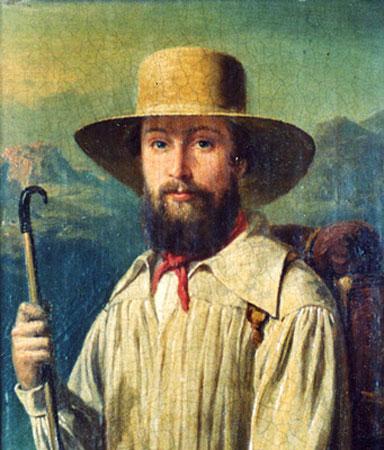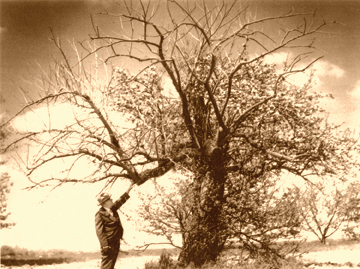Photo of John Chapman, aka Johnny Appleseed
The temperatures at night are falling, this week we see the transition to Fall, and here in Nebraska it is time for the annual Applejack Festival in Nebraska City. As all you arborists out there know, Nebraska City is the home to Arbor Day, the brainchild of J. Sterling Morton, one of Nebraska’s most famous citizens. But the season – and especially the Applejack Festival – remind me of another famous American. John Chapman, aka Jonny Appleseed.
When I was a kid, and a latchkey kid at that, I spent way too much time watching television after school. I remember watching the Walt Disney 1948 Melody Time movie The Legend of Johnny Appleseed over and over again, with the well-meaning and shoeless Chapman skipping across the plains, tossing apple seeds from his bag. In the film, a guardian angel convinces him to set out along with the other settlers headed west with nothing but a bag of seeds, a Bible, and a tin pot for a hat. After all, think of the delicious things that can be made with the apple – “the finest fruit in all the land”. He plants trees and makes friends with the animals in a scene plagiarized directly from Cinderella. Then the barefoot Chapman, with tattered clothes and a tin pot hat, moves on, occasionally checking back in to see how his trees brought neighbors together.

Johnny Appleseed from Disney’s ‘Legend of Jonny Appleseed’
There’s actually a lot of truth to the story around the edges – but misses the real Chapman – the part that really makes him an American hero. Chapman was born in 1774 and grew up during the Revolutionary War – his father was a Minuteman during the Battle of Bunker Hill – and he became an adult during the formation of the country. After the war, his father (his mother died when he was 2) taught him how to farm. He had a knack for it and developed into an accomplished orchardist and nurseryman as a young man.
He is responsible for creating the Delicious and the Golden Delicious apples, but he did not believe in grafting – attaching a live section of apple tree to the root stock of a different species. The technique has been around for over a thousand years and is the only way to make sure you get what you planted for most apple trees. Apples, unfortunately, do not reproduce themselves easily. A seed from a McIntosh apple will not grow into a McIntosh tree. Instead, it grows back as a wild volunteer apple tree. But Chapman didn’t care about that. He wasn’t trying to grow apples for pie. He was growing apples to make hard cider.
He was a devout Swedenborgian, an offshoot of Christianity that worshiped only Jesus Christ, rather than the traditional Holy Trinity. He was a vegetarian, and distained violence – even abstaining from campfires to save the insects that would be killed flying into the flame. This is also the reason he would not graft an apple tree. He believed it caused the plant to suffer. He led a simple life, preaching and converting anyone who would listen, and often traded apples for clothing. He walked an estimated 4,000 miles all over Ohio, Indiana, and Pennsylvania, but there is no evidence that he was barefoot and absolutely none that he wore a cooking pot for a hat. He was not a well-meaning goof – and instead was a shrewd capitalist and land developer.

Prior to the beginning of the 1800s, speculators and private companies were buying up huge tracts of land in the newly expanded Ohio territory, prior to it becoming a state in 1803. In 1792 the Ohio Company of Associates, in an effort to spur settlement, granted 100 acres to anyone who would establish a permanent settlement in the area. One way to prove permanence was to plant 50 apple trees and 30 peach trees within a fenced in orchard. The theory was that it took approximately 10 years for the fruit trees to mature, and one of the conditions for settlements to grow was a clean source of drinking water. The apples and peaches offered a good substitute. Prior to Prohibition, virtually all the apple orchards in the country were for the purpose of producing cider, and the peach was destined to become brandy. Water was required to sustain life, but much of it was filled with bacteria that could make the drinker sick, or even kill them. Hard cider, on the other hand, was shelf-stable and the alcohol within made the drink safe to consume.
Chapman would break ground, build his fence and plant his orchard, then move on to do it all over again. He would circle back to earlier orchards to care for them in a cycle until the orchard was established. When settlers arrived, he would sell his 100 acres with the planted orchard to them and move on and start again. At the time of his death in 1845, he still owned 1,200 acres of land in the Greater Ohio River Valley.
As settlements became towns, and towns became cities, his orchards began disappearing. Afterall, whiskey was the new American spirit-king, and wells provided clean drinking water. But we should not forget the importance of the apple in taming the West. Much of the significance of alcohol in westward expansion was whitewashed by the Temperance movement in history books and school textbooks. And sadly, once Prohibition was enacted, the government destroyed most of the remaining orchards that Chapman had planted – lest anyone begin making cider from them. Only one (known) tree is left – a Rambo apple tree in Nova, Ohio planted in 1830 that still produces fruit.

And this is where the role of the simple apple changed in America. Apple growers needed a new angle for their product. One that didn’t include alcohol. So in 1922, they rephrased an older Welsh adage ‘‘Eat an apple on going to bed, and you’ll keep the doctor from earning his bread” into the current saying that is still in use – “an apple a day keeps the doctor away” in print advertising. And we have Chapman to thank for this too. While the trees he planted in his orchards were not for consumption, he is responsible for developing several new edible varieties that are still staples at the grocery store. The work he did in developing trees from seed allowed these trees to maintain themselves without grafting – ensuring their longevity.
- Bill Stott
AotCB-010
Instagram@architecture_of_the_cocktail



